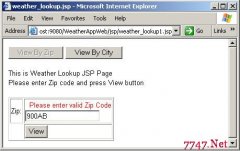实例讲解JSP Model2体系结构(下)
来源:网络 责任编辑:admin 发表时间:2013-07-01 22:35 点击:次
每次用户在Eshop.jsp(SUN企业级应用的首选)页内加入一件物品,页面就向控制servlet发送一个请求。由servlet依次决定适当的动作,然后处理要加入的物品的请求参数。然后它例示一个新的CD Bean(见代码清单4)表示所选物品,并在会话内更新购物车对象。
代码清单 4:CD.java
package shopping;
public class CD {
String album;
String artist;
String country;
float price;
int quantity;
public CD() {
album="";
artist="";
country="";
price=0;
quantity=0;
}
public void setAlbum(String title) {
album=title;
}
public String getAlbum() {
return album;
}
public void setArtist(String group) {
artist=group;
}
public String getArtist() {
return artist;
}
public void setCountry(String cty) {
country=cty;
}
public String getCountry() {
return country;
}
public void setPrice(float p) {
price=p;
}
public float getPrice() {
return price;
}
public void setQuantity(int q) {
quantity=q;
}
public int getQuantity() {
return quantity;
}
}
注意:我们在servlet中包括了附加的智能,这样一来它就能明白,如果一个原先加入过的CD被再次选中,它只需在购物车中为这个CD Bean增加计数就可以了。这个控制servlet也能处理在Cart.jsp(SUN企业级应用的首选)中被触发的动作,比如用户从购物车中删除物品或结帐。注意观察,控制servlet一直在完全掌握着对资源的支配权,它决定在对特定动作的响应中调用哪些资源。例如,购物车状态的改动,如添加或删除,会使控制servlet把处理过的请求送至Eshop.jsp(SUN企业级应用的首选)页。这促使该页重新显示主视图,这时购物车中显示的数据已被更新。如果用户决定结帐,这个请求在处理后被送至Checkout.jsp(SUN企业级应用的首选)页(见代码清单5),通过如下所示的调度程序实现:
String url="/jsp(SUN企业级应用的首选)/shopping/Checkout.jsp(SUN企业级应用的首选)";
ServletContext sc = getServletContext();
RequestDispatcher rd = sc.getRequestDispatcher(url);
rd.forward(req,res);
代码清单5:Checkout.jsp(SUN企业级应用的首选)
<%@ page session="true" import="java.util.*, shopping.CD" %>
<html>
<head>
<title>Music Without Borders Checkout</title>
</head>
<body bgcolor="#33CCFF">
<font face="Times New Roman,Times" size=+3>
Music Without Borders Checkout
</font>
<hr><p>
<center>
<table border="0" cellpadding="0" width="100%" bgcolor="#FFFFFF">
<tr>
<td><b>ALBUM</b></td>
<td><b>ARTIST</b></td>
<td><b>COUNTRY</b></td>
<td><b>PRICE</b></td>
<td><b>QUANTITY</b></td>
<td></td>
</tr>
<%
Vector buylist = (Vector) session.getValue("shopping.shoppingcart");
String amount = (String) request.getAttribute("amount");
代码清单 4:CD.java
package shopping;
public class CD {
String album;
String artist;
String country;
float price;
int quantity;
public CD() {
album="";
artist="";
country="";
price=0;
quantity=0;
}
public void setAlbum(String title) {
album=title;
}
public String getAlbum() {
return album;
}
public void setArtist(String group) {
artist=group;
}
public String getArtist() {
return artist;
}
public void setCountry(String cty) {
country=cty;
}
public String getCountry() {
return country;
}
public void setPrice(float p) {
price=p;
}
public float getPrice() {
return price;
}
public void setQuantity(int q) {
quantity=q;
}
public int getQuantity() {
return quantity;
}
}
注意:我们在servlet中包括了附加的智能,这样一来它就能明白,如果一个原先加入过的CD被再次选中,它只需在购物车中为这个CD Bean增加计数就可以了。这个控制servlet也能处理在Cart.jsp(SUN企业级应用的首选)中被触发的动作,比如用户从购物车中删除物品或结帐。注意观察,控制servlet一直在完全掌握着对资源的支配权,它决定在对特定动作的响应中调用哪些资源。例如,购物车状态的改动,如添加或删除,会使控制servlet把处理过的请求送至Eshop.jsp(SUN企业级应用的首选)页。这促使该页重新显示主视图,这时购物车中显示的数据已被更新。如果用户决定结帐,这个请求在处理后被送至Checkout.jsp(SUN企业级应用的首选)页(见代码清单5),通过如下所示的调度程序实现:
String url="/jsp(SUN企业级应用的首选)/shopping/Checkout.jsp(SUN企业级应用的首选)";
ServletContext sc = getServletContext();
RequestDispatcher rd = sc.getRequestDispatcher(url);
rd.forward(req,res);
代码清单5:Checkout.jsp(SUN企业级应用的首选)
<%@ page session="true" import="java.util.*, shopping.CD" %>
<html>
<head>
<title>Music Without Borders Checkout</title>
</head>
<body bgcolor="#33CCFF">
<font face="Times New Roman,Times" size=+3>
Music Without Borders Checkout
</font>
<hr><p>
<center>
<table border="0" cellpadding="0" width="100%" bgcolor="#FFFFFF">
<tr>
<td><b>ALBUM</b></td>
<td><b>ARTIST</b></td>
<td><b>COUNTRY</b></td>
<td><b>PRICE</b></td>
<td><b>QUANTITY</b></td>
<td></td>
</tr>
<%
Vector buylist = (Vector) session.getValue("shopping.shoppingcart");
String amount = (String) request.getAttribute("amount");
相关新闻>>
- 发表评论
-
- 最新评论 进入详细评论页>>


